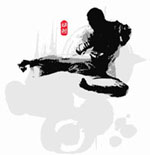|
Chapter 13. Three Materials Harmonized to Change "For what is there clouds in the sky?" "... For what does the earth need rain?"
Control
your opponent with Sool( The harmonious composition of Samjae, namely Haneul, Tang, and Saram is change, however, since the Samjae is originally only one all changes are same as one. But man commonly divides and distinguishes it for cognition, which results in nodes of change, i.e. "Rhythm". Rhythm is formality that characterizes the flow of a change. Every change has temporal flow and intervals between nodes of a flowing change compose its rhythm. Every change implies that something is altered anyhow. And the figures of the altering cannot but have nodes and intervals. Therefore, since man's action belongs to a change it also necessarily contains rhythm. There cannot be a man's motion that has no rhythm or that is beyond rhythm anyhow. It is possible for you, when doing Taekwondo, not to exclude all kinds of rhythm in your motion but only to overcome the rhythm of your usual regular motion. On the other hand, your motion is outer expression of all changes from inside of yourself, and otherwise, it would not be your own. Therefore, you must catch all changes from inside of your opponent in order to catch the rhythm in his motion. <footnotes> 1) "Samjae" refers to the three factors of sky, earth and man in the traditional oriental philosophy. In the term "Samjae", which comes from the Korean pronunciation, 'Sam' means Three while 'Jae' means Materials. The concetp of Samjae is said to be composed of Three factors but it must not be understood as such composite thing. It refers only a thing ultimately though it has three aspects. It is why I don't use "Three Essential Materials" but "Samjae". It's detailed explanation is suggested in Ch. 2-2 of On Samjae and Kang-Yu.
|